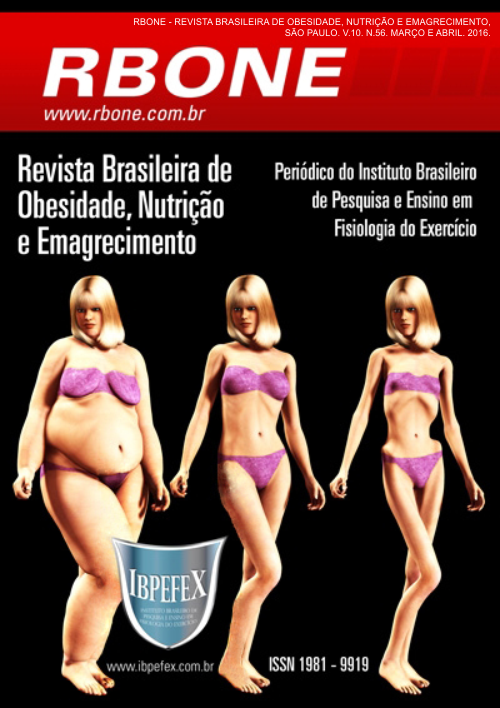The effect of 10RM in strength training on blood pressure measured with basal values through cold pressor test
Abstract
Arterial hypertension (AH) is a disease that affects about 15% of Brazilian adults, tending to raise its prevalence and is considered one of the main cardiovascular risk factors and may result in serious consequences to some organs (heart, brain, kidneys and blood vessels), it is a chronic and often late detection for its slow and silent evolution disease. Force training (PT) is an option of physicalactivities and is progressively increasing, due to accumulation of studies demonstrating the benefits and safety of its application in different contexts, also on blood pressure (AP). The aim of this study was to investigate the effect of 10RM in the TF on BP, with measured values through the Cold Pressor Test (CPT). The sample consisted of 18 male subjects, with a mean age of 23.83 (± 2.58), body mass 77.29 (± 8.49) kg and mean height of 1.77 (± 5, 10) cm, with minimum experience of six months in the TF. To measure the blood pressure and heart rate (HR) was used a pulse meter and a digital thermometer to monitor the temperature of the water in the CPT. For the statistical analysis, a descriptive analysis of the data (mean ± standard deviation) was performed using the Pearson correlation test to analyze the variables. The test results showed that there was no significant correlation between SBP and DBP in TF and CPT. We conclude that the TF may contribute to maintenance or BP reduction, reducing the incidence of cardiovascular disease and may be included in a routine physical activity as a non-pharmacological or preventive treatment.
References
-Carvalho, M. V.; Siqueira, L. B.; Sousa, A. L. L.; Jardim, P. C. B. V. A influência da hipertensão arterial na qualidade de vida, Liga de Hipertensão, 2012. Disponível em: <http://www.scielo.br/scielo.php?script=sci_arttext&pid=S0066-782X2013000200009%20>. Acesso em: 25/01/14.
-Cavalcante, J. W. S.; Cavalcante, L. P.; Pacheco, W. S.; Menezes, M. G. F.; Gama Filho, C.G. Comportamento da pressão arterial em filhos de normotensos e filhos de hipertensos submetidos a estímulos pressóricos, Arquivo Brasileiro de Cardiologia, 1997. Disponível em: <http://www.scielo.br/pdf/abc/v69n5/3691.pdf> Acesso em: 27/01/14.
-Forjaz, C. L. M.; Rezk, C. C.; Melo, C. M.; Santos, D. A.; Teixeira, L.; Nery, S. S.; Tinucci, T. Exercício resistido para o paciente hipertenso: Indicação ou contra indicação, Revista Brasileira de Hipertensos. 2003.
-Gatti, R. M.; Santos, B. R. M.; Furlaneto, C. J.; Goulart, R. M. M.; Moreira, P.A. Avaliação dos fatores de risco para doença arterial coronariana em pacientes de São Caetano do Sul segundo o escore de Framingham e sua relação com a síndrome metabólica, Arquivo Sanny Pesquisa e Saúde.2008. Disponível em:<http://www.cepsanny.com.br/pdf/v1n1a2.pdf> Acesso em: 17/02/14.
-Leite, T. C.; Farinatti, T.V. Estudo da frequência cardíaca, pressão arterial e duplo-produto em exercícios resistidos diversos para grupamentos musculares semelhantes, Revista Brasileira de Fisiologia do Exercício, 2003. Disponível em: <http://boletimef.org/biblioteca/417/Leite-Farinatti-Artigo>.Acesso em: 25/01/14.
-Marsaro, E. A.; Vasquez, E. C.; Lima, E. G. Avaliação da pressão arterial em indivíduos normais e hiper-reatores. Um estudo comparativo dos métodos de medidas casual e da MAPA. Arquivo Brasileiro de Cardiologia, 1996. Disponível em: <http://publicacoes.cardiol.br/abc/1996/6705/67050004.pdf>.Acesso em: 22/01/14.
-Mion Jr., D.; Kohlmann Junior, O.; Machado, C.A.; e colaboradores. V diretrizes brasileiras de hipertensão arterial, Sociedade Brasileira de Cardiologia, 2007. Disponível em <http://www.scielo.br/pdf/abc/v89n3/a12v89n3.pdf>.Acesso em: 17/02/14.
-Mishra, S.; Manjareeka, M.; Mishra, J. Blood pressure response to cold water immersion test, International Journal of Biology, Pharmacy and Allied Science. 2012.
-Oliveira, H. L.; Adura, M.; Neto, M.R. A prova do frio no estudo da pressão arterial, Revista de Medicina, 1941. Disponível em: <http://www.revistas.usp.br/revistadc/article/viewFile/50519/54635>. Acesso em: 15/01/14.
-Richter, C. M.; Panigas, T. F.; Bündchen, D. C.; Dipp, T.; Belli, K. C.; Viecili, P.R.N. Redução dos níveis pressóricos em indivíduos hiper-reativos após treinamento físico aeróbio, Sociedade Brasileira de Cardiologia. 2010. Disponível em: <http://www.scielo.br/pdf/abc/v95n2/en_aop08310.pdf>.Acesso em: 22/01/14.
-Simão, R.; Fleck, S. J.; Polito, M.; Walace, M.; Farinatti, P. Effects off resistance training intensity, volume, and session format on the postexercise hypotensive response, Journal of Strength and Conditioning Research, 2005. Disponível em: <http://journals.lww.com/nsca-jscr/Abstract/2005/11000/Effects_of_Resistance_Training_Intensity,_Volume,.22.aspx>. Acesso em: 22/01/14.
-Simão, R.; Poly, M. A.; Lemos, A. Prescrição de exercícios através do teste de T1 RM em homens treinados, Fitness & Performance Journal, 2003. Disponível em: <http://www.fpjournal.org.br/painel/arquivos/1518-6_Homens_treinados_Rev1_2004_Portugues.pdf>.Acesso em: 8/11/14.
-Tolufo, P.A.O escore de risco de Framingham para doenças cardiovasculares, Revista de Medicina, 2008.Disponível em:<http://www.revistas.usp.br/revistadc/article/view/59084/0>.Acesso em: 17/02/14.
-Vieira, F. L. H.; Lima, E.G. Testes de estresse laboratoriais e hipertensão arterial, Revista Brasileira de Hipertensão, 2007.
-Victor, R. G.; Leimbach, W. N.; Seals, D. R.; Wallin, B. G.; Mark, A.L. Effects of the Cold Pressor Test on muscle sympathetic nerve activity in humans, The Journal of American Heart Association.1987.Disponível em: <http://hyper.ahajournals.org/content/9/5/429> Acesso em: 16/01/14.
-Wood, D. L.; Sheps, S. G.; Elveback, L. R. Cold Pressor Test as a predictor of hypertension, The Journal of American Heart Association, 1984. Disponível em: <http://hyper.ahajournals.org/content/6/3/301>.Acesso em: 15/01/14.
Authors who publish in this journal agree to the following terms:
- Authors retain the copyright and grant the journal the right of first publication, with work simultaneously licensed under the Creative Commons Attribution License BY-NC which allows the sharing of the work with acknowledgment of the authorship of the work and initial publication in this journal.
- Authors are authorized to enter into additional contracts separately for non-exclusive distribution of the version of the work published in this journal (eg, publishing in institutional repository or book chapter), with acknowledgment of authorship and initial publication in this journal.
- Authors are allowed and encouraged to post and distribute their work online (eg, in institutional repositories or on their personal page) at any point before or during the editorial process, as this can bring about productive change as well as increase impact and impact. citation of published work (See The Effect of Free Access).






